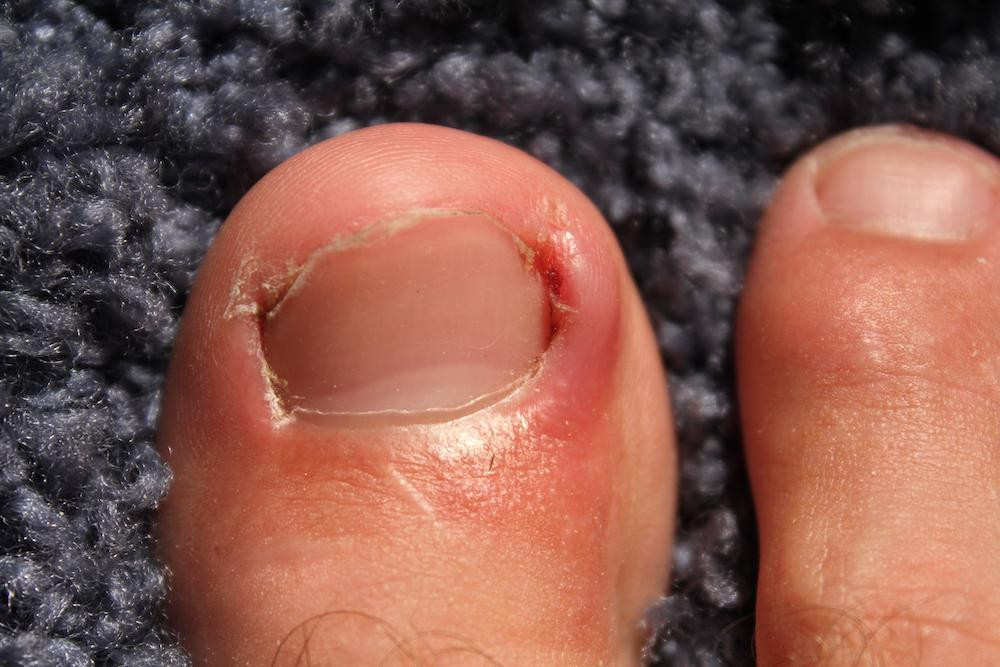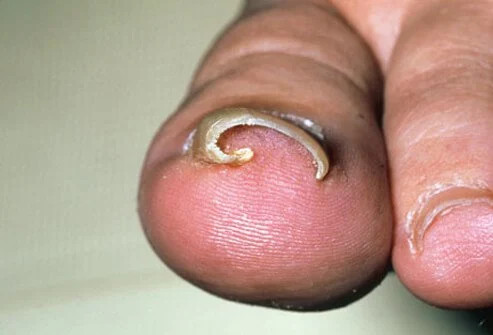Definisi
Ingrown toenail atau onikokriptosis atau cantengan merupakan sebuah kondisi ketika bagian sudut atau sisi kuku tumbuh ke dalam kulit. Cantengan lebih sering terjadi pada kuku kaki dibandingkan kuku tangan. Dari semua kuku kaki, cantengan paling sering terjadi pada ibu jari kaki. Cantengan dapat ditangani sendiri, namun dapat pula ditangani oleh dokter.
Penyebab
Penyebab cantengan dapat berupa:
- Memotong kuku dengan arah yang tidak benar (misalnya memotong kuku mengikuti bentuk jari, sehingga bagian ujung dapat tumbuh ke dalam kulit)
- Kuku yang bentuknya tidak teratur atau keriting
- Alas kaki yang memberikan tekanan besar pada ibu jari kaki, misalnya kaos kaki dan stocking yang terlalu ketat, atau sepatu yang terlalu ketat, sempit, atau datar untuk kaki Anda
- Cedera pada kuku, misalnya tersandung, menaruh beban berat di kaki, atau menendang bola berkali-kali
- Postur tubuh yang buruk
- Kebersihan kaki yang buruk, misalnya membiarkan kaki kotor dan lembap
- Pengaruh genetik
Faktor Risiko
Cantengan dapat terjadi pada pria dan wanita. Namun, risiko akan lebih tinggi jika seseorang memiliki kaki yang berkeringat banyak, misalnya pada remaja. Selain itu, orang lanjut usia juga berisiko tinggi karena kuku semakin tebal seiring dengan usia. Tidak hanya itu, masalah pada pembuluh darah atau aliran darah seperti diabetes dapat meningkatkan risiko cantengan.
Penggunaan kaki ketika berolahraga dapat membuat Anda rentan terhadap cantengan. Aktivitas yang memberikan tekanan pada kaki dalam jangka waktu lama, atau melibatkan menendang objek tertentu juga dapat menyebabkan kerusakan kuku dan meningkatkan risiko terjadinya cantengan. Aktivitas tersebut dapat berupa balet, sepakbola, kickboxing, dan rugby.
Gejala
Cantengan pada umumnya menyakitkan dan semakin parah seiring waktu. Gejala awal yang dapat muncul berupa:
- Kulit di sekitar kuku menjadi merah, bengkak, atau keras
- Nyeri ketika kuku ditekan
- Cairan berkumpul di dekat kuku
Jika kuku terinfeksi, gejala yang bisa terlihat antara lain:
- Kulit yang merah dan bengkak
- Nyeri
- Perdarahan
- Keluarnya nanah
- Pertumbuhan kulit yang berlebih di sekitar kuku
Diagnosis
Dokter dapat mendiagnosis cantengan berdasarkan keluhan dan gejala Anda. Dokter juga akan memeriksa kuku kaki Anda untuk memastikan diagnosis dan menentukan tata laksana yang tepat. Dokter juga mungkin akan melakukan pemeriksaan rontgen apabila kuku kaki tampak terinfeksi. Pemeriksaan ini dapat membantu dokter melihat sejauh mana kuku telah tumbuh ke dalam kulit.
Tata Laksana
Jika cantengan belum mencapai infeksi, Anda dapat menanganinya sendiri dengan cara sebagai berikut:
- Merendam kaki. Anda dapat mengurangi pembengkakan dan rasa nyeri dengan merendam kaki Anda dengan air hangat selama 15-20 menit, 3-4 kali sehari
- Menjaga agar kaki tetap kering. Anda perlu membiarkan kulit kaki Anda “bernapas” untuk menghindari keringat atau kelembapan
- Menggunakan krim antibiotik. Anda dapat menutupnya dengan perban setelahnya untuk melindungi kuku tersebut
- Memilih sepatu yang dapat membantu penyembuhan. Anda dapat memilih sepatu dengan ujung yang terbuka atau sepatu dengan ruang yang cukup luas untuk jari Anda. Jangan menggunakan sepatu hak tinggi
- Mengonsumsi obat antinyeri. Obat antinyeri yang dijual bebas seperti parasetamol dan ibuprofen dapat membantu menurunkan bengkak dan nyeri
Jika gejala Anda tidak membaik (atau bahkan memburuk) dalam beberapa minggu, Anda dapat berkunjung ke dokter. Dokter dapat melakukan hal sebagai berikut:
- Meresepkan antibiotik. Anda mungkin akan membutuhkan antibiotik salep atau minum untuk mengobati infeksi bakteri pada kuku
- Mengangkat kuku. Jika masalah Anda ringan dan tidak melibatkan nanah, dokter dapat berusaha untuk mengangkat sebagian kuku dan memindahkan posisinya agar dapat tumbuh di atas kulit
- Membuang sebagian kuku. Dokter akan memberikan obat bius sebelum melakukan bedah ringan untuk mengangkat sebagian kuku yang tumbuh ke dalam kulit
- Membuang seluruh kuku. Jika Anda mengalami cantengan berulang kali pada kuku yang sama, dokter dapat memutuskan untuk membuang seluruh kuku. Kuku Anda membutuhkan waktu sekitar 1 tahun untuk tumbuh ke ukuran semula. Selain itu, risiko cantengan ulang akan semakin tinggi saat kuku tersebut tumbuh kembali
Setelah pembuangan kuku, jari kaki Anda akan diperban. Anda perlu mengangkat kaki selama 1-2 hari setelahnya dan menggunakan sandal khusus agar jari Anda sembuh dengan baik. Anda sangat disarankan untuk menghindari gerakan terlalu banyak pada kaki.
Biasanya, perban akan diambil 2 hari setelah pembedahan. Dokter juga akan menyarankan Anda untuk menggunakan sepatu dengan ujung terbuka dan merendam kaki dengan air garam sampai kuku membaik. Dokter juga akan meresepkan obat antibiotik minum dan antinyeri untuk mencegah infeksi dan menangani nyeri yang muncul.
Komplikasi
Jika tidak ditangani dengan baik, cantengan dapat menyebabkan infeksi pada tulang jari. Infeksi ini juga dapat menyebabkan tukak pada kaki, serta penurunan aliran darah ke daerah tersebut. Kematian dan pembusukan jaringan juga dapat terjadi.
Infeksi pada kaki dapat menjadi lebih parah jika Anda memiliki diabetes. Luka lecet kecil dan cantengan menjadi lebih rentan terinfeksi akibat penurunan aliran darah dan kerusakan saraf.
Jika Anda membawa sifat genetik yang menyebabkan Anda rentan terkena cantengan, Anda dapat mengalaminya berulang kali atau pada beberapa jari sekaligus. Kualitas hidup Anda mungkin akan terganggu akibat rasa sakit, infeksi, dan masalah kaki lainnya yang membutuhkan beberapa kali pembedahan. Pada kasus seperti ini, dokter dapat merekomendasikan pembuangan seluruh kuku yang menyebabkan nyeri berkepanjangan.
Pencegahan
Pencegahan cantengan dapat dilakukan dengan cara sebagai berikut:
- Memotong kuku dengan lurus mendatar. Jangan memotong kuku Anda melengkung, mengikuti bagian depan jari, karena dapat membuat kuku tumbuh ke dalam kulit. Jika Anda melakukan perawatan pedicure, Anda dapat meminta hal ini pada orang yang memotong kuku Anda
- Menjaga panjang kuku sedang. Anda sebaiknya memotong kuku sejajar dengan ujung jari kaki Anda. Jika Anda memotong kuku kaki terlalu pendek, tekanan sepatu pada kuku Anda dapat mengarahkan kuku untuk tumbuh ke dalam kulit
- Menggunakan sepatu yang berukuran pas. Sepatu yang terlalu menekan jari atau bahkan menjepit jari dapat menyebabkan kuku tumbuh ke dalam kulit. Jika Anda mengalami kerusakan saraf pada kaki, Anda mungkin tidak dapat merasakan apabila sepatu Anda terlalu ketat
- Menggunakan alas kaki pelindung. Jika aktivitas Anda meningkatkan risiko melukai jari, Anda dapat menggunakan alas kaki pelindung, seperti sepatu dengan pelindung jari yang terbuat dari baja
- Memeriksa kaki Anda. Jika Anda mengalami diabetes, Anda perlu memeriksa kaki Anda setiap hari untuk mencari adanya cantengan atau masalah kaki lainnya
Kapan Harus ke Dokter?
Anda dapat berkunjung ke dokter apabila Anda merasakan nyeri yang luar biasa pada jari kaki Anda yang mengalami cantengan, serta adanya kulit merah dan nanah yang menyebar. Anda juga sebaiknya berkunjung ke dokter apabila Anda mengalami cantengan dan memiliki diabetes. Jika Anda mengalami kondisi lainnya yang menyebabkan aliran darah ke kaki buruk (seperti penyakit arteri perifer), Anda juga dapat berkonsultasi kepada dokter untuk tata laksana cantengan.
Mau tahu informasi seputar penyakit lainnya? Cek di sini, ya!
- dr Hanifa Rahma
Begum, J. (2021). Ingrown Nail. Retrieved 19 May 2022, from https://www.webmd.com/skin-problems-and-treatments/understanding-ingrown-nail-basics
Ingrown toenails - Symptoms and causes. (2022). Retrieved 19 May 2022, from https://www.mayoclinic.org/diseases-conditions/ingrown-toenails/symptoms-causes/syc-20355903
Johnson, S., & Morrison, W. (2019). Ingrown Toenails: Causes, Symptoms, and Diagnosis. Retrieved 19 May 2022, from https://www.healthline.com/health/ingrown-toenail









